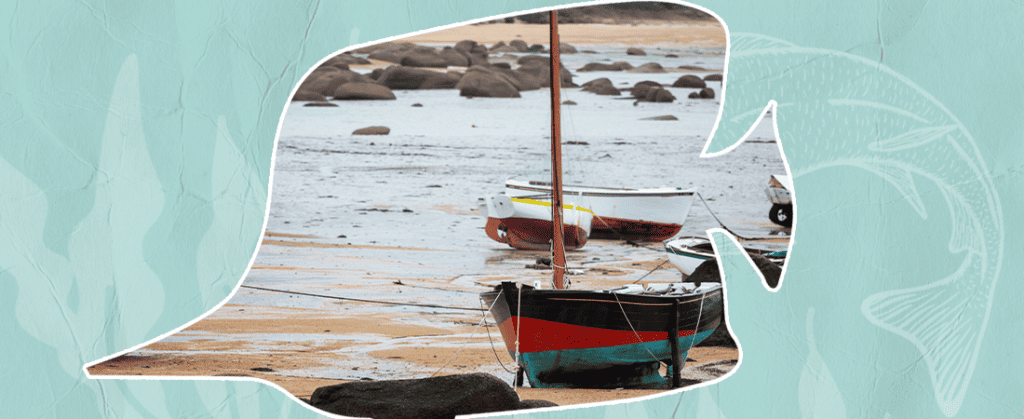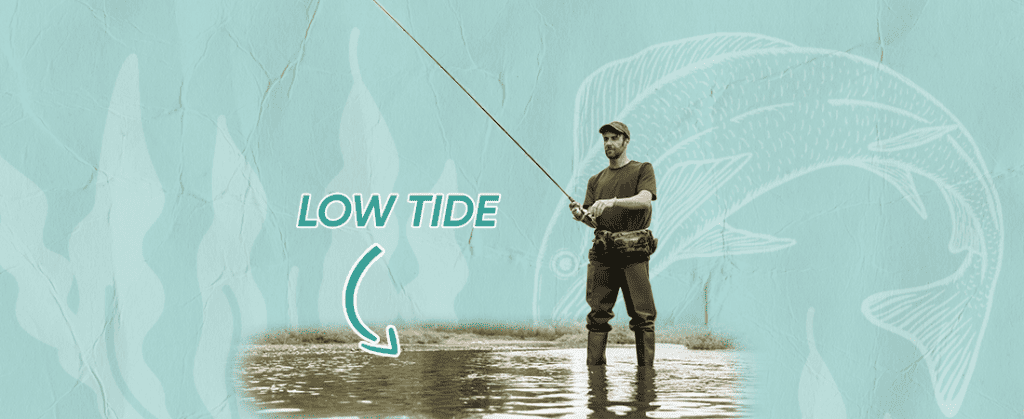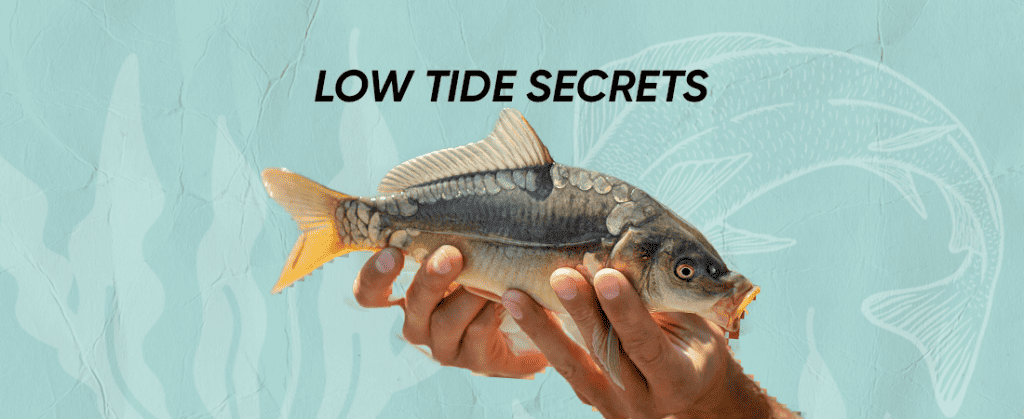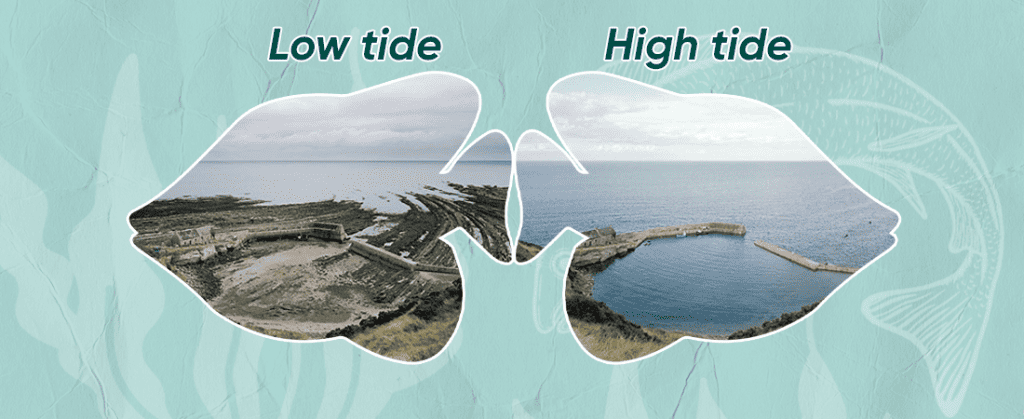
Surf fishing at low tide can be challenging but is worth trying. Low water levels push fish into inactivity, narrowing your fishing area. The real challenge in low tide fishing is finding fish since they are in hiding. But once you find these spots, you will land some game fish.
But how do you fish in a low tide? Can you catch fish at low tide? What types of fish can you catch, and what are the best lures? Is it better to fish in low or high tide? Find answers to these questions in this guide.

Written by
Larry Stark, Founder / Main Editor
Professional fisherman, who loves to review new fishing gadgets.
Table of Contents
How to Fish in Low Tide

Are you wondering is low tide good for saltwater fishing? Well, it has its benefits. Think of low tides as nature’s way of restricting movement.
Fish can get as close to the shore as possible while concealed in deeper water during a high tide. But when water levels fall, they are forced to move from shallow grass flats into cuts, troughs, and deeper channels to await the tide’s return. The limited movement makes them easy fishing targets once you spot them.
The first place to look for predator fish is the edges. They prefer areas where island edges or shallow flats drop into a trough. Deep holes are another excellent location to cast bait as predator fish lay here in wait for small fish to move across the edges.
Also, do not ignore mullet schools, which may help you catch fish. Birds, too, help locate baitfish that lead you to larger fish.
To prepare for low tide fishing, check the local tidal prediction for accurate times and expected weather changes. Many anglers report having better fishing success days before a storm. Or, opt for calm, clear days for better casting accuracy and visibility.
Regarding windy weather, you can use the wind to your advantage. Wind moves the water, sparking activity in small schools of fish. Casting bait in the direction of the wind can land you larger fish chasing down baitfish. Suspending baits and soft plastics are your ideal lures in windy conditions. We have a separate guide for saltwater lures that you could use for low tide fishing.
Additionally, the blowing wind causes water to mix with sand and mud. Murky waters lower visibility, concealing your saltwater fishing lines. So when you cast the bait, fish respond to movements increasing bites.
Lastly, consider the water temperatures and time of the year when fishing during low tide. Fish are more active in spring, early summer, and fall. They then become sluggish in winter and mid-summer. So, do not beat yourself up if you catch nothing in the slow seasons.
Would you go fishing at low tide? Here are three benefits of doing so.
You can catch more fish if you find deeper channels of water. Fish retreat to these pools with no way to return to the ocean. If you find these spots and cast the bait in a slow retrieve, these fish will readily take the bite.
Low tide on windy days lowers visibility by making the water murky. This hides your fishing gear that could spook fish.
It grants access to areas with deeper water you would not reach during a high tide. You can easily find fish congregated in deeper flats and edges when the tide falls.
What’s Low Tide Fishing Tips

Keep these tips in mind when fishing at a low tide:
- Identify suitable finesse baits for your target species
- Use a slow, steady retrieve to avoid spooking the fish
- Change the location if you do not find feeding fish in 15 minutes
- Familiarize yourself with the dangers of low-water fishing, such as strong tidal waves, aggressive high tides, poisonous organisms, and dangerous terrain
- Wear insulated waders when fishing on foot
- Learn the safe boating depths for better route planning
- Track tides with a tide app
What Types of Fish Can You Catch at Low Tide?

Now that we have answered the question, can you fish at low tide? The following are the types of fish you can catch.
Redfish
Snook
Trout
Pompano
Whiting
Flounder
Goliath grouper
Bluefish
Ladyfish
Jack crevalle
You are likely to find Pompano close to the first sandbar. They love sand fleas and will move to areas with lots of them. Redfish, trout, bluefish, jack crevalle, and ladyfish are usually in deeper water, waiting for the rising tide. Trout hide in deeper channels but can be found around passes and bridges.
What Are the Best Lures & Baits to Use During Low Tide?
We recommend using small baits and lures since most fish do not aggressively feed during low tides. Also, present the bait in slow motion since the fish are in a calm state and less interested in the chase.
The best redfish lures are spoons, topwaters, subsurface lures, spinnerbaits, jerkbaits, swimbaits, artificial crabs, and shrimp. Regarding color, redfish are mainly attracted to golden lures, but red, green, and silver also work. You can also use live bait like mullet, pogies, pilchards, and greenies.
When fishing trout, use scent-infused bait to appeal to their senses and bright colors to draw attention. Spinnerbaits are the best trout lures for active and sluggish trout, but you can also use minnows, night crawlers, and human food like Velveeta cheese and marshmallows. If you need help choosing saltwater spinning rods, read this guide: 7 Best Saltwater Fishing Rods.
Meanwhile, shrimp imitation baits, jigheads, and soft plastics are among the top snook lures. Aim for chartreuse-colored (yellow-green), red, and yellow lures as they are more effective. You can also use live shrimp, crabs, mullet, or croakers.
Pompano love sand fleas, so you rig them as natural bait. These fish will also eat live or dead shrimp, fiddler crabs, and cut squid. Unfortunately, you will not find pompanos on re-nourished beaches. New sand only kills marine life in the sandy zone, including sand fleas, and it takes a few years for the ecosystem to restore itself.
Lastly, Goliath groupers eat various fish and often bite any bait presented. Some of the best natural baits are squid, sardines, chub mackerel, white crab, mullet, and octopus pieces. And they do not mind whether the bait is alive or dead.
Differences Between Outgoing and Incoming Tides
Water movement causes outgoing and incoming tides. An outgoing tide, a falling tide or ebb current, carries bait from creeks and channels into the estuary. Game fish hunt for baitfish at the mouth of the estuary, a reason why many anglers prefer this spot as the tide goes out.
On the other hand, an incoming tide, also called a rising tide or flooding tide, pushes water from the ocean and into the estuary area. This water is much clearer than the existing water in the estuary and contains higher oxygen levels. These conditions encourage fish activity and feeding, making this a great time to go saltwater fishing.
Basic flats, beach points, and flooded structures are the best fishing spots during an incoming tide. Predatory fish use flats to ambush baitfish as they contain food from the flooding tide. They also wait at beach points for easy meals or flooded structures near docks, grass lines, or piling.
And there is an additional tide known as a slack tide. It is a short period characterized by no water movement. Slack tide occurs between incoming and outgoing tides and features the weakest tidal flow.
Do Fish Bite Better in Low or High Tide?
Fish do not bite better when the tide is at its highest (high tide) or its lowest (low tide). Rather, the periods between the high and low peaks are the best times to fish.
When the water levels reach peak high or low tide, it stops moving to become stagnant (slack tide). This also causes small baitfish and nutrients to become stagnant, reducing predator fish activity. During this time, fish are less interested in taking the bait.
Also, when the waters recede, fish move from shallow water into areas with deep water to wait for the next tide. Only after you identify these areas will you get the fish to bite.
But you can get more bites when the tide is running. This is when the tide flows from high to low and vice versa. Rising and falling tides carry around nutrients, small animals, and plants, drawing small baitfish, predator fish, and other marine wildlife.
But what causes tides? High and low tides are a result of the moon’s gravity. The moon’s gravitational pull generates a tidal force that causes oceans to budge out.
The earth’s side closest to the moon experiences a bulge in water levels, known as high tide. At the same time, the opposite side also experiences a high tide from resisting the moon’s gravitational pull. Meanwhile, the sides between the bulges experience low tides with shallow water levels.
Most people have no difficulty identifying low and high tides in parts of the ocean shoreline. But if the tide changes are subtle in your area, search the internet for local tidal information. Websites that regularly update weather forecasts are an excellent place to start. Also, look up nautical websites for information on saltwater tides.
Alternatively, download a Tide app. Most Tide apps are up-to-date, extremely accurate, and reliable. You can even use the app to record where you found deeper holes when low tide beach fishing.
Rivers and lakes also have low tides, but they are less noticeable than oceans. The tidal range in lakes is only a few inches, and a few feet in rivers.
Low tides do not significantly impact saltwater fishing success in lakes due to their smaller size. But when the low tide is coupled with other weather conditions like rain, cloud cover, and cold fronts, it can make or break your fishing trip.
